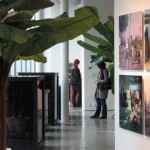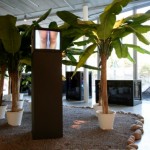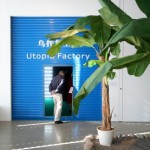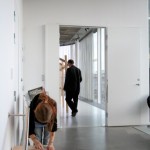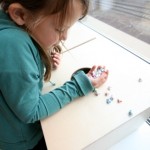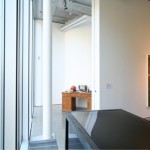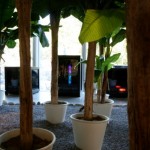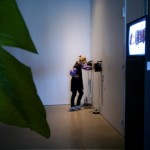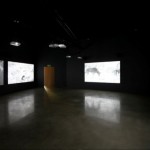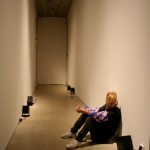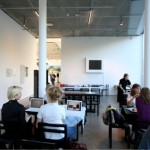A talk between Sara Arrhenius and Zhang Wei
Stockholm, late afternoon, 28 May 2008
Sara Arrhenius (The Director of Bonniers Konsthall):Today we are sitting and talking in the reading room at Bonniers Konsthall with its large windows facing out onto the empty Stockholm streets lit by the early Nordic summer light. But our conversation also started here, over a year ago on a very, very cold, dark winter's day. It was the first time we had met, and I remember you asked for a cup of hot water, and then we sat down and talked for several hours at the kitchen table in our office. Since then, our conversations have been going on continually, travelling with us through some of the more crowded cities of China: Beijing, Shanghai and Guangzhou, and by e-mail, Skype and telephone. However movable and temporary it was, this dialogue has, for me, been the core of our work on the exhibition. I think the simplicity of two people sitting down together talking could also work as an image of how I wanted the making of the exhibition to be set up as an exchange, in which ideas could move, influence and change each other. I think this process of change and travel is beautifully expressed in your exhibition title: Sprout from White Nights, which, among other things, refers to the white nights of the North and to the way the works of a group of Chinese artists are translated into this context.
Zhang Wei: Before addressing this question, I would like to tell a story. I was sick in New York and I asked a friend of mine to introduce me to a Chinese doctor (I like a Chinese doctor if I am not really sick). She introduced me to a very good one and told me that I was in good hands. The moment I met him, I realized that he was Polish rather than Chinese, but he was a Chinese doctor. I was a bit suspicious of his skills, but he told me that he must be one of the best Chinese doctors that I have ever visited. In the end he was right. After the treatment, we talked about the philosophy of Chinese medicine and also about other aspects of culture in China. After this conversation with him, I find it interesting to try to understand Chinese culture. As a curator I am not interested in China as a nation, but as a culture. I am interested in how that specific cultural context and perspective could be understood in the present time, which can also interact and be shared with other individuals from other cultures. While working as a guest curator here at Bonniers Konsthall, I don't see myself as setting up a collaboration between China and Sweden, but between me and you and the rest of the team at Bonniers Konsthall - with individuals. Actually we are not only making an exhibition which collects some artworks from China and relocates them in Bonniers Konsthall to show the audience something about China, but we are also creating an experience and sensation of China using artists' creativity. In order to realize these intentions, dialogue, communication and changing each other's perspective on the process of making the show are very important. I am interested in what happens in this meeting. How we push each other and the tensions that occur which let us get to know each other. We are creating an experience, an encounter. I think these connections and ways of working are very interesting and also reveal new possibilities for collaboration in contemporary art. We have a moving, travelling community that is neither Chinese nor Swedish, but based more on individuals who exist internationally.
SA: We have witnessed an immense interest in Chinese art in recent years, followed by a boom in the Chinese art market. On the international art scene, on both an institutional and commercial level, the term Chinese art has almost become a trademark and has created an expanding art industry in China in a very short time. As an editor of NU: The Nordic Art Review I took part in a similar development on a much humbler level - the rise of international interest in Nordic art during the late 90's. "The Nordic Miracle", as it was called by Hans Ulrich Obrist - who, with the large show Nuit Blanche at the Musée d'Art Moderne de la Ville de Paris, was himself an active agent - was in many ways very important and transformative for Nordic artists and curators of that generation. With the China Power Station show he played a similar role for a generation of Chinese artists. It is interesting to discuss, but difficult to predict, the consequences of these waves of movement, and how to work with or against them on a curatorial level. These national labels are always very handy for the art system, and they do open up possibilities for artists to reach out, become visible and take part in international art discourse. But they also involve obvious problems, such as the risk of turning whole regions into soon-to-fade fashions on the art market. In the case of China one could, of course, also wonder if it is at all productive and meaningful to talk about "Chinese art" for such a large and diverse culture as China.
ZW: I think there are different ways to approach and understand art. We live in the industrial world today, so it is not a surprise that art has been and is being produced artificially. But if we don't think about all the techniques or artificial terms as ways to approach art, then is there another way of perceiving or experiencing art? One possibility is to look at artists' creativity based on the need for artists to express themselves within their own daily situations. Chinese contemporary art has no history yet, which makes the situation very open for people to talk about Chinese art through different approaches. For me as a person growing up in China and living my daily life in China, thinking about Chinese art connects to the experience of artists living their daily life in China, to making art in response to daily life in China. Thinking about the show here, I wanted to think outside the idea of a collection of brilliant artworks. I wanted to shift the perspective and ask questions about the artist as an individual living in contemporary China. I was interested in the situation in which art becomes the mediator or tool for artists setting up their own space and relationship to the world. It is an exhibition about artists' experiences of their social space in contemporary China. The challenge was to realize an exhibition which could function as a mediator, a tool which could help us to experience, to sense contemporary Chinese life.
SA: When working with a project like this, translation is a central concern. What is being lost when art is moved to another context? What is being added? How are we transforming meaning, inventing new languages? For me an important part of our dialogue has been to create a sensitivity to the process of translation, to make it visible and not take it for granted that there is a seamless transference, but instead a dialogue with inconsistencies, contradictions and dissonances. For me it has been essential to allow myself to change and to take pleasure in switching my own definitions back and forth. What I get back in the process of translation is something different from what I give out.
ZW: When we are in the position of having an encounter between different cultures, it is important to accept the feeling of confusion caused by the different cultures. We always get used to what we know and try to hold on to it and then to impose it on others. In fact, that is not translation but it is more like colonisation. In the contemporary world, we not only have to accept that there is not just one value in the world, but also have to learn how to share these different values. We must get used to translation never being about explaining something exactly, trying to tell others what it is. I think rather than translating, it is more about understanding yourself and others in the confusing situation of the mixture of different cultures. This is a creative process in which you have to understand that the translation has to be open. The purpose of translating is to build up a new form which can work both for you and others, not to copy something into another language. You have to be present in the translation, rather than to keep a distance; it is a process rather than a two-dimensional information delivery.
SA: Travelling with you in China, talking to the artists, it struck me how differently they formulated the role of the artist in society, in contrast to the Western tradition of the intellectual understood as an outsider, a critical agency outside of the system. In contemporary China, the artists seemed more like a motor within the system and in many cases a symbol of the dynamics of the new China. The Chinese artist as a global entrepreneur of creativity and a moving, active agent in the booming art industry is a striking image of the enormous changes in Chinese society, the extreme economic growth, urbanisation and globalisation. The Chinese artist and Chinese art seemed to me be inside this storm, a part of creating it rather than critically contemplating it from the outside.
ZW: Chinese art does not try to analyze or define, but to act and create. The Chinese artist is not an outsider, but is within life. What is essential is how you respond to reality and how you create your own social space. In Chinese society there are no divisions or layers between art and life, it is all mixed together. Artists like Yang Fudong and Xu Tan have inherited a lot from the traditional role of the Chinese intellectual. They explore individual and spiritual existence in their own time. There is a spiritual continuity, but the material form has changed. Those threads going back to ancient Chinese thought are very important. What is vital is not to describe life, but to create it. That is a very important aspect of the show and the publication: creating a social sensation rather than social knowledge. Then I think what you saw in China is also about generations. The artists in the show belong to a generation that has experienced such massive change from communism to Chinese capitalism. They know that everything can change so fast and that what they have created could be erased in a moment, and they have to recreate and rebuild. They have, as I have, experienced how everything we believed in was changed, which creates a situation in which you are nowhere. You have to cope with reality, but you also have to construct something to believe in.
SA: I guess your own creation of Vitamin Creative Space is an example of that. It seems to me like a space that avoids all the conventional definitions that are usually attached to intuitions in the art field. It is an independent space, gallery, publisher, production unit and curatorial group - all at the same time. You manifest yourself both in China and internationally, setting up situations, projects, publications and exhibitions both as a group and as individuals. I think in many ways your working methods seem to relate to the present situation in China - you seem to change constantly, reinventing yourself all the time. I think it would be very interesting to hear more about how you set up the space and how it grew out of the situation in China. What were the possibilities and what were the limitations? I remember you told me when I was visiting you in Guangzhou that working from there offered you more freedom than Beijing, where you now have an office.
ZW: Vitamin Creative Space has changed so rapidly. In the beginning it was very simple: there was no independent art space in China, and especially no art space in Guangzhou. So just setting up the space made us very necessary. But today, the whole context is more complicated, which means we are not only in a Chinese context, but also in an international one. In that sense, rethinking space is very important. In China there are no restrictions on the distinctions between an institution, a commercial gallery and a non-profit space, because we don't have a public funding system. So what is important is that you yourself become the institution, rather than having officially defined institution boundaries. In that sense, a commercial gallery, art space, publications and shows, are just different platforms for expressing ideas, and more importantly we think of all these platforms as different spaces which are open to sharing different ideas, not only in China but also internationally. In that sense, Vitamin Creative Space itself is an experimental space, and the idea of that space is space within space within space.
SA:We talked for a long time about how to continue and develop in the publication the dialogue that was the "sprout" of the exhibition, and for me it was very interesting to follow the way the publication grew out of that discussion and became a vital part of the exhibition, as much as an independent art work and more than a conventional catalogue. I guess that this process is in many ways a telling example of how you think of the publication not as an explanation of the exhibition, but as a space that adds another layer to the show.
ZW: The publication is really another interesting space which we can explore a lot. Working with a publication is the same as curating an exhibition, but in two-dimensional space. It is also an extended field of the physical space. Each publication is an encounter with a new space. With the Sprout publication, it is more about exploring the artist's inner world through the means of expression of words, while some texts also provide a broader social context. The whole publication is not there to give explicit information or to critique the artists' works, rather these words by the artists and the various authors create a kind of a sensation of Chinese reality. In a way, the artists' words themselves become a critique of their works and living contexts in a more poetic way.
SA: When we started the dialogue about your project, I was working on a group show called Against Time here at Bonniers Konsthall, investigating the obsession with lost time and the restaging of history in contemporary art and literature. In a way, that exhibition became a background for a conversation between you and me about the differences between concepts of time and the use of history in European and Chinese traditions, and how they mutually influenced and modified each other. It is interesting to reconnect with this discussion when looking at the artists you have invited to the show. There is, for example, in the work of Yang Fudong and the Yangjiang Group a reworking of Chinese history through both ancient images and techniques, reminding me of the artistic strategies of the artists I worked with for Against Time, such as Gerard Byrne or Robert Kusmirowski. Even if historical images, anachronisms and a reworking of lost time are also visible in your show. I have the impression that they are articulated and worked out very differently.
ZW: For me it was interesting to see how your show approached similar issues to those of the artists I work with, but dealt with them in a very different way. The artists I work with in the show are slow, you have to spend time with their work and be patient - there I saw a correspondence. But I think there is one fundamental cultural difference. These artists' works don't speak about time and history - they live it, they make time in their work. I think there is a difference there in the way of perceiving things and setting up a relationship with reality in comparison with the Western art tradition. One thing that has permeated Chinese culture is the present - the sensation of living in the present. And by that I don't mean the present in an uncomplicated banal way, but as one of the central concepts in ancient Chinese philosophy. In this the sensation of the present is a certain sensibility, which has to be developed as a skill. You can see the roots of the work of the Yangjiang Group in that philosophy when they get drunk to create that special state of mind that allows them to be in the present and to create. The same with the garden that Zheng Guogu is building, which has no plan, but where everything is worked out in the present. You can also see something similar in Cao Fei's works when she constructs virtual social environments as in RMB City, which contains the possibility of shaping the world according to her imagination.


